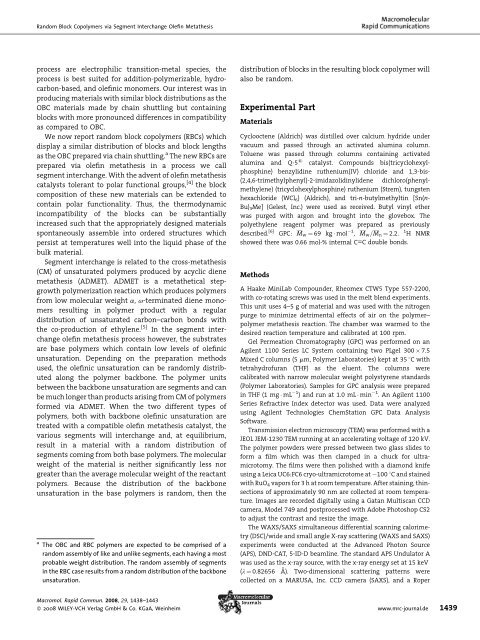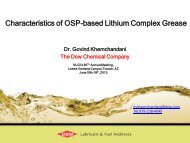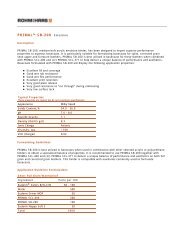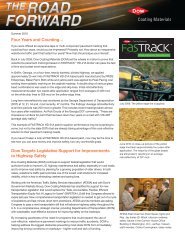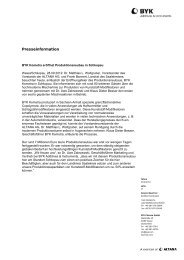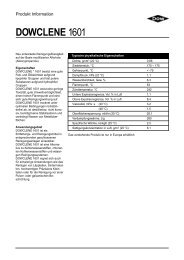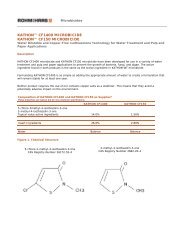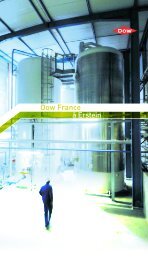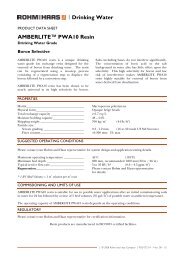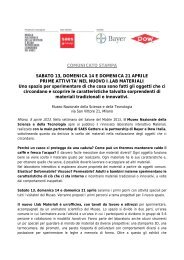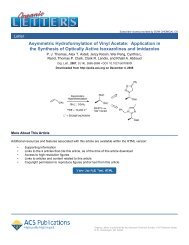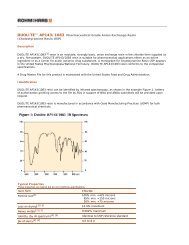Random Block Copolymers via Segment Interchange Olefin ...
Random Block Copolymers via Segment Interchange Olefin ...
Random Block Copolymers via Segment Interchange Olefin ...
Create successful ePaper yourself
Turn your PDF publications into a flip-book with our unique Google optimized e-Paper software.
<strong>Random</strong> <strong>Block</strong> <strong>Copolymers</strong> <strong>via</strong> <strong>Segment</strong> <strong>Interchange</strong> <strong>Olefin</strong> Metathesis<br />
process are electrophilic transition-metal species, the<br />
process is best suited for addition-polymerizable, hydrocarbon-based,<br />
and olefinic monomers. Our interest was in<br />
producing materials with similar block distributions as the<br />
OBC materials made by chain shuttling but containing<br />
blocks with more pronounced differences in compatibility<br />
as compared to OBC.<br />
We now report random block copolymers (RBCs) which<br />
display a similar distribution of blocks and block lengths<br />
as the OBC prepared <strong>via</strong> chain shuttling. a The new RBCs are<br />
prepared <strong>via</strong> olefin metathesis in a process we call<br />
segment interchange. With the advent of olefin metathesis<br />
catalysts tolerant to polar functional groups, [4] the block<br />
composition of these new materials can be extended to<br />
contain polar functionality. Thus, the thermodynamic<br />
incompatibility of the blocks can be substantially<br />
increased such that the appropriately designed materials<br />
spontaneously assemble into ordered structures which<br />
persist at temperatures well into the liquid phase of the<br />
bulk material.<br />
<strong>Segment</strong> interchange is related to the cross-metathesis<br />
(CM) of unsaturated polymers produced by acyclic diene<br />
metathesis (ADMET). ADMET is a metathetical stepgrowth<br />
polymerization reaction which produces polymers<br />
from low molecular weight a, v-terminated diene monomers<br />
resulting in polymer product with a regular<br />
distribution of unsaturated carbon–carbon bonds with<br />
the co-production of ethylene. [5] In the segment interchange<br />
olefin metathesis process however, the substrates<br />
are base polymers which contain low levels of olefinic<br />
unsaturation. Depending on the preparation methods<br />
used, the olefinic unsaturation can be randomly distributed<br />
along the polymer backbone. The polymer units<br />
between the backbone unsaturation are segments and can<br />
be much longer than products arising from CM of polymers<br />
formed <strong>via</strong> ADMET. When the two different types of<br />
polymers, both with backbone olefinic unsaturation are<br />
treated with a compatible olefin metathesis catalyst, the<br />
various segments will interchange and, at equilibrium,<br />
result in a material with a random distribution of<br />
segments coming from both base polymers. The molecular<br />
weight of the material is neither significantly less nor<br />
greater than the average molecular weight of the reactant<br />
polymers. Because the distribution of the backbone<br />
unsaturation in the base polymers is random, then the<br />
a The OBC and RBC polymers are expected to be comprised of a<br />
random assembly of like and unlike segments, each having a most<br />
probable weight distribution. The random assembly of segments<br />
in the RBC case results from a random distribution of the backbone<br />
unsaturation.<br />
distribution of blocks in the resulting block copolymer will<br />
also be random.<br />
Experimental Part<br />
Materials<br />
Cyclooctene (Aldrich) was distilled over calcium hydride under<br />
vacuum and passed through an activated alumina column.<br />
Toluene was passed through columns containing activated<br />
alumina and Q-5 1 catalyst. Compounds bis(tricyclohexylphosphine)<br />
benzylidine ruthenium(IV) chloride and 1,3-bis-<br />
(2,4,6-trimethylphenyl)-2-imidazolidinylidene dichloro(phenylmethylene)<br />
(tricyclohexylphosphine) ruthenium (Strem), tungsten<br />
hexachloride (WCl 6) (Aldrich), and tri-n-butylmethyltin [Sn(n-<br />
Bu)3Me] (Gelest, Inc.) were used as received. Butyl vinyl ether<br />
was purged with argon and brought into the glovebox. The<br />
polyethylene reagent polymer was prepared as previously<br />
described. [6] GPC: Mw ¼ 69 kg mol 1 , Mw=Mn ¼ 2.2. 1 H NMR<br />
showed there was 0.66 mol-% internal C–C doublebonds.<br />
Methods<br />
A Haake MiniLab Compounder, Rheomex CTW5 Type 557-2200,<br />
with co-rotating screws was used in the melt blend experiments.<br />
This unit uses 4–5 g of material and was used with the nitrogen<br />
purge to minimize detrimental effects of air on the polymer–<br />
polymer metathesis reaction. The chamber was warmed to the<br />
desired reaction temperature and calibrated at 100 rpm.<br />
Gel Permeation Chromatography (GPC) was performed on an<br />
Agilent 1100 Series LC System containing two PLgel 300 7.5<br />
Mixed C columns (5 mm, Polymer Laboratories) kept at 35 8C with<br />
tetrahydrofuran (THF) as the eluent. The columns were<br />
calibrated with narrow molecular weight polystyrene standards<br />
(Polymer Laboratories). Samples for GPC analysis were prepared<br />
in THF (1 mg mL 1 ) and run at 1.0 mL min 1 . An Agilent 1100<br />
Series Refractive Index detector was used. Data were analyzed<br />
using Agilent Technologies ChemStation GPC Data Analysis<br />
Software.<br />
Transmission electron microscopy (TEM) was performed with a<br />
JEOL JEM-1230 TEM running at an accelerating voltage of 120 kV.<br />
The polymer powders were pressed between two glass slides to<br />
form a film which was then clamped in a chuck for ultramicrotomy.<br />
The films were then polished with a diamond knife<br />
using a Leica UC6:FC6 cryo-ultramicrotome at 100 8C and stained<br />
with RuO4 vapors for 3 h at room temperature. After staining, thinsections<br />
of approximately 90 nm are collected at room temperature.<br />
Images are recorded digitally using a Gatan Multiscan CCD<br />
camera, Model 749 and postprocessed with Adobe Photoshop CS2<br />
to adjust the contrast and resize the image.<br />
The WAXS/SAXS simultaneous differential scanning calorimetry<br />
(DSC)/wide and small angle X-ray scattering (WAXS and SAXS)<br />
experiments were conducted at the Advanced Photon Source<br />
(APS), DND-CAT, 5-ID-D beamline. The standard APS Undulator A<br />
was used as the x-ray source, with the x-ray energy set at 15 keV<br />
(l ¼ 0.82656 A˚ ). Two-dimensional scattering patterns were<br />
collected on a MARUSA, Inc. CCD camera (SAXS), and a Roper<br />
Macromol. Rapid Commun. 2008, 29, 1438–1443<br />
ß 2008 WILEY-VCH Verlag GmbH & Co. KGaA, Weinheim www.mrc-journal.de 1439


